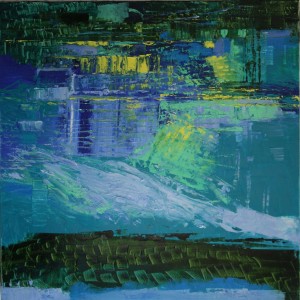I invite you to guess and vote on which of the 4 versions below is the original design of this painting completed yesterday.
Monthly Archives: September 2014
William Zimmer essay on Linda Holt’s paintings
Linda Holt’s aim is to be a top dog painter and it’s likely that in America, where the poker playing dog is king, she has the field all to herself—at least where dog likenesses that are also art is concerned. In the history of dog painting only one American, a woman in the early 20th century named Maud Earl, has made the history books. She received academic training from her father and took into account the animal’s skeletal structure. It is significant that she was half British–for over there dog painting is a serious genre. The king of dog painters, the Victorian Edwin Henry Landseer, anthropomorphized his subjects. Holt, too, has a talent for making dogs seem all too human.
Holt studied painting at the University of Pennsylvania where her primary instructors were Alex Katz and Neil Welliver. It’s quite transparent what these artists contributed to Holt’s art; above all a sense of boldness. Her major paintings are insistently frontal and her images are usually outsized, larger than life. These traits echo Katz, the essence of places like the New York art world and Eastern Long Island is embodied in larger than life heads of the major players.
Welliver’s decisiveness is embodied in the stark landscape of rural Maine; every detail of his intricate compositions stands out clearly. Holt’s first exhibited paintings reveal both her landscape training and an innate sense of glamour. She painted Japanese carp, whose beauty might be only skin-deep. They’re beautiful as they glide through the water, and sometimes the watery environment replete with water lilies takes over as the real subject. But this surface beauty conceals what conservationists don’t like about carp; they are bottom feeders that dirty the water. The negatives are visually absent from Holt’s paintings. What we have is a decorative, semi-exotic sort of beauty strengthened by Holt’s mastery of painterly basics like perspective and foreshortening. But it’s a beauty that has an edge to it because of the animal qualities it masks. Likewise, a kind of edginess amid ostensible innocence is a quality of her best dog paintings.
As Holt describes it, her conversion to painting dogs was spontaneous, the result of her glancing at her own two cocker spaniels one day and noticing, through a painter’s eye, how “funny” their expressions were, especially their eyes. The artistic decisions that Holt made putting her dogs on canvas are striking. In her best paintings the image is only the head looming large; the background is often pure white (although in the painting titled “Tub” the white is the porcelain environment where her two dogs stand. It’s where their baths are given, but the two dogs are oddly placid.
The expressions, possibly with a little anthropomorphism at work, are the major force in the paintings featuring her own dogs. Benign expressions do dominate Holt’s dog oeuvre to date, but being human the viewer will gravitate to paintings featuring a greater or lesser degree of what we would interpret as anger. These flashy attitudes are more like life. Where these cockers, (originally bred as hunters), have quarry in their mouths, Holt only paints a piece of it, to not diminish the visual strength of the face.
Holt rightly believes that commissions are the best route to take, and here concessions must be made. She must put in squares of tile or the stripes of a sofa–these factors tie the owner to the dog. But Holt has been called the John Singer Sargent of dog painting. Sargent subsisted largely on commissions; he knew he had to please his sitters yet his own attitudes still came through. Such is Linda Holt’s challenge. Then dog painting in America will have its day.
William Zimmer
New York City











